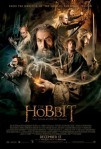The Hobbit: Desolation of Smaug (Movie Review)

The Hobbit: Desolation of Smaug
The Desolation of Smaug is the second movie in the Hobbit trilogy. I found it to be fun and very polished, though a little disappointing. In short, Peter Jackson succeeded at making the light fantasy action movie that he wanted, but it felt like there was a lot of wasted potential.
For the most part, the movie was most enjoyable when it added scenes to Tolkien’s original. Gandalf’s investigations into the evil of Dol Guldur feel like generic fantasy, but they tie in to the Lord of the Rings movies very well. A new subplot about elves hunting orcs is as slick and emotionless as a video game, but Peter Jackson excels at these bubblegum action scenes. And even the flashback where Gandalf first meets Thorin is a nice way to round out the plot.
But the scenes that were originally in he book are flattened out, since the humor, characters and subtleties were apparently getting in the way of extra orc battles. Bilbo’s taunting and outwitting of the giant spiders? Replaced with a huge fight, even though actor Martin Freeman could have made that very fun. Stumbling on an Elven feast? Nah, it’s more efficient just to have the Elves appear out of nowhere and capture everyone. Conversations with Beorn, or developing his interesting character? Gone completely. In fact, Beorn is the most confusing change, since he offered a lot of opportunity for visual effects and badass fights. Instead, his appearance is so brief and irrelevant that people who have read the book will feel cheated and people who haven’t will wonder what the point was of including him at all.
But the most disappointing changes were to Smaug. The dragon looks incredible, and Benedict Cumberbatch’s CGI performance feels suitably inhuman. Expect some well-deserved Oscar victories for this creation. But in the story, it’s less impressive. For the first few minutes, the dragon feels enormous, unpredictable, and scary. But he gets what feels like an hour of screentime with a series of new chase scenes. No characters ever get caught by him, and by the end his apparent threat level has dropped from “could beat up Godzilla” to “the Looney Tunes coyote”.
As I said in last year’s Hobbit review, Peter Jackson needed to make changes to the book. I’m comfortable with the thematic tie-ins to Lord of the Rings and even to the dumb-but-fun orc attacks that keep happening. (One battle, fought as the Dwarves float downriver on barrels, is laugh-out-loud funny and incredibly creative.) But I wish it hadn’t also dumbed down the source material. It’s fun, and funny, in ways beyond shooting orcs with arrows. Desolation of Smaug brings us breathtaking sets and special effects, frenetic action, and Manly Fantasy Brooding™. That’s not enough to sustain it, especially since the movie runs for almost three hours and it sometimes compares poorly to the kids’ book it’s based on. It is sufficient, but just barely, to make this worth watching, though I don’t feel as forgiving as I did a year ago.
Grade: B-
